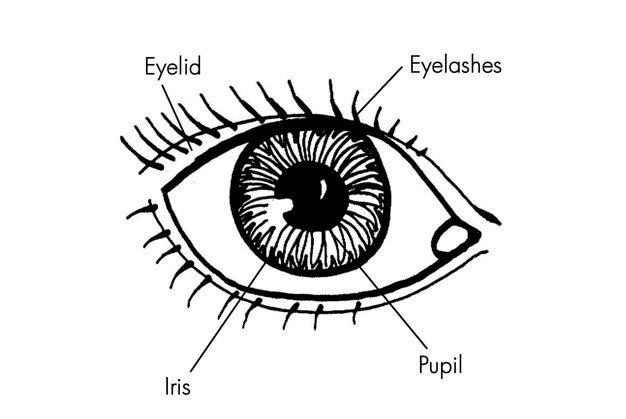Parts of Human Eye.

Our eyes are one of the essential tools we use to process the world around us. They allow us to interpret shapes, faces, colours, and depth by translating the light that reflects off of these things into electrical signals that the brain reads as images.
The eyes sit in cone-shaped cavities in the skull called sockets which are surrounded by six motion-regulating muscles and multiple layers of fatty tissue that help to protect the eye and give it flexibility. Eyebrows, eyelashes, and eyelids also contribute to this effort.
The eye is made of 10 general components that all work together to keep us seeing well every day.
Our eye is a slightly asymmetrical globe, which is about an inch in diameter. The front part (which is visible in the mirror) includes:
- Iris: The coloured part.
- Cornia: A clear dome over iris.
- Pupil: The black circular opening in the iris that lets light in.
- Lens: Is responsible for allowing eyes to focus on small details.
- Vitreous Humour: Gel-like substance that helps to keep the eyeball in its proper, circular shape.
- Retina: Area at the back of the eye that receives the refined, visual message
- Sclera: The white part of your eye.
- Iris – The iris is the coloured part of the eye. It might seem purely cosmetic, the iris function to adjust the size of the pupil, it has muscles that contract or expands, depending on the amount of light the pupil needs to process images.
- Cornea – The cornea is the outermost layer of the eye and is primarily responsible for focusing the light that comes into our eyes. There are five layers to the cornea. Outer layer acts as a kind of shield to the elements and can usually repair itself within a few days of suffering a minor injury. The deeper layers exist mainly to strengthen the eye.
- Pupil – The pupil is a black circle in the centre of the eye, and its primary function is to monitor the amount of light that enters into the eye. When there is a lot of light, the pupil contracts to keep the light from overwhelming the eye. When there is very little light, the pupil expands so it can soak up as much as possible.
- Lens – The lens which is behind the pupil and is responsible for allowing your eyes to focus on small details like words in your book. The lens is in a constant state of adjustment as it becomes thinner or thicker to accommodate the detailed input it receives. With age, the lens loses a lot of its elasticity which often results in cataracts and presbyopia because the lens cannot adjust as well to its surroundings as it used to.
- Vitreous Humour – The vitreous humour is a gel-like substance that helps to keep the eyeball in its proper, circular shape. This is the area in the eye where floaters develop as pieces of the vitreous humour clump together and cast shadows onto the retina. With age, the vitreous humour begins to shrink and can cause problems like posterior retinal detachment or retinal tear.
- Retina -The retina is the area at the back of the eye that receives the refined, visual message from the front of the eye, and it transmits that visual message to the brain using electrical signals.
- Sclera -The sclera is the white part of the eye, and its primary function is to provide strength, structure, and protection for the eye. The sclera contains blood vessels that can tell an eye doctor a lot about the state of your overall health.
Just behind the iris and pupil lies the lens, which helps focus light on the back of your eye. Most of the eye is filled with a clear gel called the vitreous — light projects through your pupil and lens to the end of the eye. The inside lining of the eye is covered by specialized light-sensing cells that are collectively called the retina. It converts light into electrical impulses. Behind the eye, your optic nerve carries these impulses to the brain. The macula is a small extra-sensitive area in the retina that gives you central vision.
Eye colour is created by the amount and type of pigment in your iris. Multiple genes inherited from each parent determine a person’s eye colour.
We’ve created this content for informational purposes only, and it reflects the views of its respective authors/entities (freelancers/interns) and not those of Winspire Magazine. Winspire Magazine does not endorse or vouch for the accuracy of the information provided in this content. It is the reader’s responsibility to verify and ensure the information is correct and up-to-date. Winspire Magazine disclaims any liability or responsibility for any damages or losses from using this content. Therefore, readers should take all necessary steps to verify the accuracy and reliability of any information presented in this content.


